Native American/ European Timeline of Events
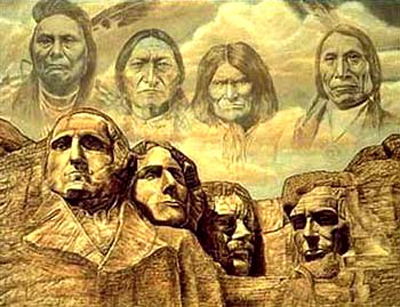
1492
From their nakedness, Columbus inferred the native people to be an inferior race. Columbus wrote of the Indians he encountered, "They all go around as naked as their mothers bore them; and also the women." However, he noted that "they could easily be commanded and made to work, to sow and to do whatever might be needed, to build towns and be taught to wear clothes and adopt our ways." Although Columbus also wrote that "they are the best people in the world and above all the gentlest," his record of the first encounter between Europeans and New World Indians was filled with accounts of enslavement, murder, and rape.
1513
In May, Ponce de Leon encountered Calusa Indians while exploring the Gulf Coast of Florida near Charlotte harbor. In a fight with the Calusa, de Leon captured four warriors.
1524
On July 8, the first kidnapping in America took place. Florentine explorers kidnapped an Indian child to bring to France.
1528
On April 16, the first significant exploration of Florida occurred when Spanish soldier, explorer, and Indian fighter Panfilo de Narvaez saw Indian houses near what is now Tampa Bay. Narvaez claimed Spanish royal title to the land.
1540
Francisco Vasquez de Coronado led Mexico's invasion of the north with an expeditionary force of 300 conquistadors and more than one thousand Indian "allies." When they reached Cibola, they found not the promised metropolis but "a little, crowded village, looking as if it had been crumpled all up together." This was the Zuni Pueblo of Hawikuh, whose warriors answered with arrows when Coronado demanded that they swear loyalty to his King. Within an hour, the Spaniards overran the pueblo, and over the next few weeks, they conquered the other Zunis in the region.
Coronado moved his camp to the upper Rio Grande, where his soldiers confiscated one pueblo for winter quarters and looted the surrounding pueblos for supplies. During this operation, a Spaniard raped an Indian woman, and when Coronado refused to punish him, the Indians retaliated by stealing horses. Lopez de Cardenas attacked the thieves' pueblo, captured 200 men and methodically burned them all at the stake.
1541
Faced with an incipient uprising, Francisco Vasquez de Coronado ordered an attack on Moho pueblo, a center of Indian resistance. His men were repulsed when they tried to scale the walls, so they settled in for a siege that lasted from January through March. At last, when the Moho tried to slip away, the Spaniards killed more than 200 men, women and children in a massacre that pacified the region.
1542
Under pressure from religious leaders, especially the Dominican friar Bartolome de Las Casas, Spanish Emperor Carlos V attempted to impose "New Laws" on the Spanish colonies, ending the encomienda system that gave settlers the right to Indian slave labor.
1546
The "New Laws" barring Indian enslavement were repealed at the insistence of New World colonists, who developed a society and economy dependent on slave labor.
1552
Bartolome de Las Casa, the first priest ordained in the Western hemisphere and chief architect of the now-defunct "New Laws" against Indian enslavement, published Brief Relations of the Destruction of the Indies, which provided many gruesome examples of the colonists' treatment of Indians.
1598
On November 15, Don Juan O�ate declared possession of Hopi land (in what is now northern Arizona) in the name of the Spanish crown. Four hundred years later, the Hopi have still never signed any treaty with any non-Indian nation.
1600's
Europeans of the time held steadfastly to the belief that their introduced diseases were acts of God being done in their behalf. One settler proclaimed while speaking about the deaths of Native Americans, "Their enterprise failed, for it pleased God to effect these Indians with such a deadly sickness, that out of every 1000, over 950 of them had died, and many of them lay rotting above the ground for lack of burial."
1607
Jamestown is founded in Virginia by the colonists of the London Company. By the end of the year, starvation and disease reduce the original 105 settlers to just 32 survivors. Captain John Smith is captured by Native American Chief Powhatan and saved from death by the chief's daughter, Pocahontas.
On July 3, Indians brought maize, beans, squash, and fresh and smoked meat to the Jamestown colony. As at Plymouth years later, the colonists and their diseases would eventually exterminate them.
1609
On July 29, Samuel de Champlain, accompanied by 2 other Frenchmen and 60 Algonquins and Hurons, defeated a band of Iroquois Indians near the future Ticonderoga, beginning a long period of French/Iroquois enmity.
1611
Former Dutch lawyer Adrian Block explored Manhattan Island in the ship Tiger. He returned to Europe with a cargo of furs and two kidnapped Indians, whom he named Orson and Valentine.
1614
On May 13, the Viceroy of Mexico found Spanish Explorer Juan de O�ate guilty of atrocities against the Indians of New Mexico . As part of his punishment, he was banned from entering New Mexico again.
1616
A smallpox epidemic decimates the Native American population in New England.
In May, Virginia�s Deputy Governor George Yeardley and a group of men killed 20 - 40 Chickahominy Indians. It was under Yeardley�s leadership that friendly relations between the Chickahominy and the colony ended.
1621
One of the first treaties between colonists and Native Americans is signed as the Plymouth Pilgrims enact a peace pact with the Wampanoag Tribe, with the aid of Squanto, an English speaking Native American.
1626
Peter Minuit, a Dutch colonist, buys Manhattan island from Native Americans for 60 guilders (about $24) and names the island New Amsterdam.
1637
In the colony of Massachusetts the Pequod Indians were the first slaves, but as they "would not endure the yoke," they were sent to the Bermudas and exchanged for Negroes in the hope that the latter would bear slavery more patiently. The first exchange of Indians for Negroes was made in 1637, the first year of the Pequod war and was doubtless kept up for many years.
On May 26, Captains John Mason and John Underhill attacked and burned Pequot forts at Mystic, Connecticut, massacring 600 Indians and starting the Pequot War.
On June 5, English settlers in New England massacred a Pequot Indian village.
1639
Captain William Pierce of Salem, Massachusetts sailed to the West Indies and exchanged Indian slaves for black slaves.
1675-1676
King Philip's War erupts in New England between colonists and Native Americans as a result of tensions over colonist's expansionist activities. The bloody war rages up and down the Connecticut River valley in Massachusetts and in the Plymouth and Rhode Island colonies, eventually resulting in 600 English colonials being killed and 3,000 Native Americans, including women and children on both sides. King Philip (the colonist's nickname for Metacomet, chief of the Wampanoags) is hunted down and killed on August 12, 1676, in a swamp in Rhode Island, ending the war in southern New England and ending the independent power of Native Americans there. In New Hampshire and Maine, the Saco Indians continue to raid settlements for another year and a half.
July 30, 1676
Bacon's Rebellion - Tobacco planters led by Nathan Bacon ask for and are denied permission to attack the Susquehannock Indians, who have been conducting raids on colonists' settlement. Enraged at Governor Berkeley's refusal, the colonists burn Jamestown and kill many Indians before order is restored in October.
1690
The beginning of King William's War as hostilities in Europe between the French and English spill over to the colonies. In February, Schenectady, New York is burned by the French with the aid of their Native American allies.
1702
French explorer Pierre Liette had a four-year sojourn in the Chicago area during which he noticed that "the sin of sodomy" prevailed among the Miami Indians, and that some men were bred from childhood for this purpose.
1704
On June 23, former Governor of South Carolina, James Moore, led a force of 50 British, and 1,000 Creek Indians against Spanish settlements. They attacked a Mission in Northwestern Florida. They took many Indians as slaves and killed Father Manuel de Mendoza.
1709
A slave market was erected at the foot of Wall Street and here Negroes and Indians, men, women and children were daily declared the property of the highest cash bidder.
1711
Hostilities break out between Native Americans and settlers in North Carolina after the massacre of settlers there. The conflict, known as the Tuscarora Indian War will last two years.
1715
Yamasee tribes attack and kill several hundred Carolina settlers.
1716
South Carolina settlers and their Cherokee allies attack and defeat the Yamassee.
1721
Jesuit explorer Pierre Francois Xavier de Charlevoix recorded effeminacy and widespread homosexuality and lesbianism among the �Indian� tribes in what is now Louisiana. The most prominent tribes in the area at the time were the Iroquois and Illinois.
1725
Ten sleeping Indians were scalped by whites in New Hampshire for a bounty.
1745
Upon hearing of an impending French and Indian attack upon the Ulster county frontiers, Europeans massacred several Indian families in their wigwams at Walden in the Hudson River Valley.
1745
On November 28, French military forces out of Canada, accompanied by 220 Caughnawaga Mohawk and Abenaki Indians, attacked and burned the English settlement at Saratoga. The 101 inhabitants were either killed or taken prisoner.
1752
In the 1752 census, 147 "Indian" slaves � 87 females and 60 males � were listed as living in French households in what would later be called Illinois. These people were from different cultural groups than the local Native American population and were often captives of war.
1754
On April 9, an Indian slave trader sent a letter to South Carolina Governor J. Glenn asking for permission to use one group of Indians to fight another: "We want no pay, only what we can take and plunder, and what slaves we take to be our own."
1756
On April 8, Governor Robert Morris declared war on the Delaware and Shawnee Indians. Included in his war declaration was �The Scalp Act,� which put a bounty on the scalps of Indian men, women and boys.
1758
On August 1, the first Indian reservation in North America was established by the New Jersey Colonial Assembly.
1759
Responding to a Comanche attack that destroyed two missions on the San Saba River in central Tejas, a Spanish force of 600 marched north to the Red River where they engaged several thousand Comanche and other Plains Indians fighting behind breastworks and armed with French rifles. The Spaniards were routed, losing a cannon in their retreat, and Comanche raids became a constant threat to settlers throughout Tejas.
1762
Governor Thomas Velez Cachupin had a number of Indians living at Albiqui� [La Ca�ada, New Mexico ] tried for witchcraft sometime after 1762. They were conveniently condemned into servitude.
1763
In May, the Ottawa Native Americans under Chief Pontiac begin all-out warfare against the British west of Niagara, destroying several British forts and conducting a siege against the British at Detroit. In August, Pontiac's forces are defeated by the British near Pittsburgh. The siege of Detroit ends in November, but hostilities between the British and Chief Pontiac continue for several years.
The Proclamation of 1763, signed by King George III of England, prohibits any English settlement west of the Appalachian mountains and requires those already settled in those regions to return east in an attempt to ease tensions with Native Americans.
An indication of the basic racism inherent in the use of violence by colonial whites can be found in the notorious Paxton Boys. In 1763 this group of frontier thugs did not hesitate to kill dozens of friendly Christian Indians, for they were easier to get at than the hostiles who would put up a fight. The Paxton Boys mostly beat their victims to death, though they did not scruple at using axes. Yet when they marched on Philadelphia to press their claims for more funding and arms for a war against the Indians, they were met by an armed militia, and their forces melted away. Only some 250 Paxton Boys remained, and they were intellectually outnumbered by Benjamin Franklin, who offered these �white savages� a face-saving out. The western insurgents presented a pro-murder petition to the legislature, an amazing exercise in projection that argued that Indians should be killed because they were prone to massacre innocents. The point is, again, that these white rebels contented themselves with a petition and then went home. The legislature ignored their drivel. In brief, then, personal violence in colonial America appears to have been reserved for despised races.
On December 8, an organization compensating settlers for losses resulting from Indian raids was created by Indian Commissioner Sir William Johnson.
On December 27, a troop of 50 armed men entered the Workhouse at Lancaster, Pennsylvania, and hacked to death the only 14 surviving Conestoga Indians (the rest of the tribe having been similarly dispensed with 13 days earlier).
1775
Forced to labor in the mission fields and to worship according to the missionaries' teachings, the Indians at San Diego rebelled against the Spanish, burning every building and killing most of the inhabitants, including the mission's head priest. Thanks to a Spanish sharpshooter, the Indians were finally driven off and the Spanish retained control of their outpost.
1776
On May 25, the Continental Congress resolved that it was "highly expedient to engage Indians in service of the United Colonies," and authorized recruiting 2,000 paid auxiliaries. The program was a dismal failure, as virtually every tribe refused to fight for the colonists.
1776
On July 21, Cherokee Indians attacked a settlement in western North Carolina. Militia forces retaliated by destroying a nearby Cherokee village.
1772-1780
4/5 of the Arikara died of smallpox, measles, etc.
1781
Smallpox wiped out more than half the Piegan Blackfeet.
1782
On March 8, Captain David Williamson and about 90 volunteer militiamen slaughtered 62 adults and 34 children of the neutral, pacifist, and Christian Delaware people at Gnadenhutten, Ohio in retaliation for raids by other Indian tribes.
On April 21, the Presidio, overlooking San Francisco, was erected by the Spanish to subdue Indians interfering with mail transmissions along El Camino Real.
1786
On July 13, the Northwest Ordinance was enacted, stating "the utmost good faith shall always be observed toward the Indians . . . in their property, rights, and liberty they shall never be disturbed."
1787
First federal treaty enacted with the Delaware Indians.
1789
Indian Commerce Clause of the Constitution is added stating "The Congress shall have Power...to regulate Commerce with foreign Nations, and among the several States, and with the Indian Tribes." This clause is generally seen as the principal basis for the federal government's broad power over Indians.
Indian affairs assignation. Indian agents, who were appointed as the federal government's liaison with tribes, fell under jurisdiction of the War Department. The Indian agents were empowered to negotiate treaties with the tribes.
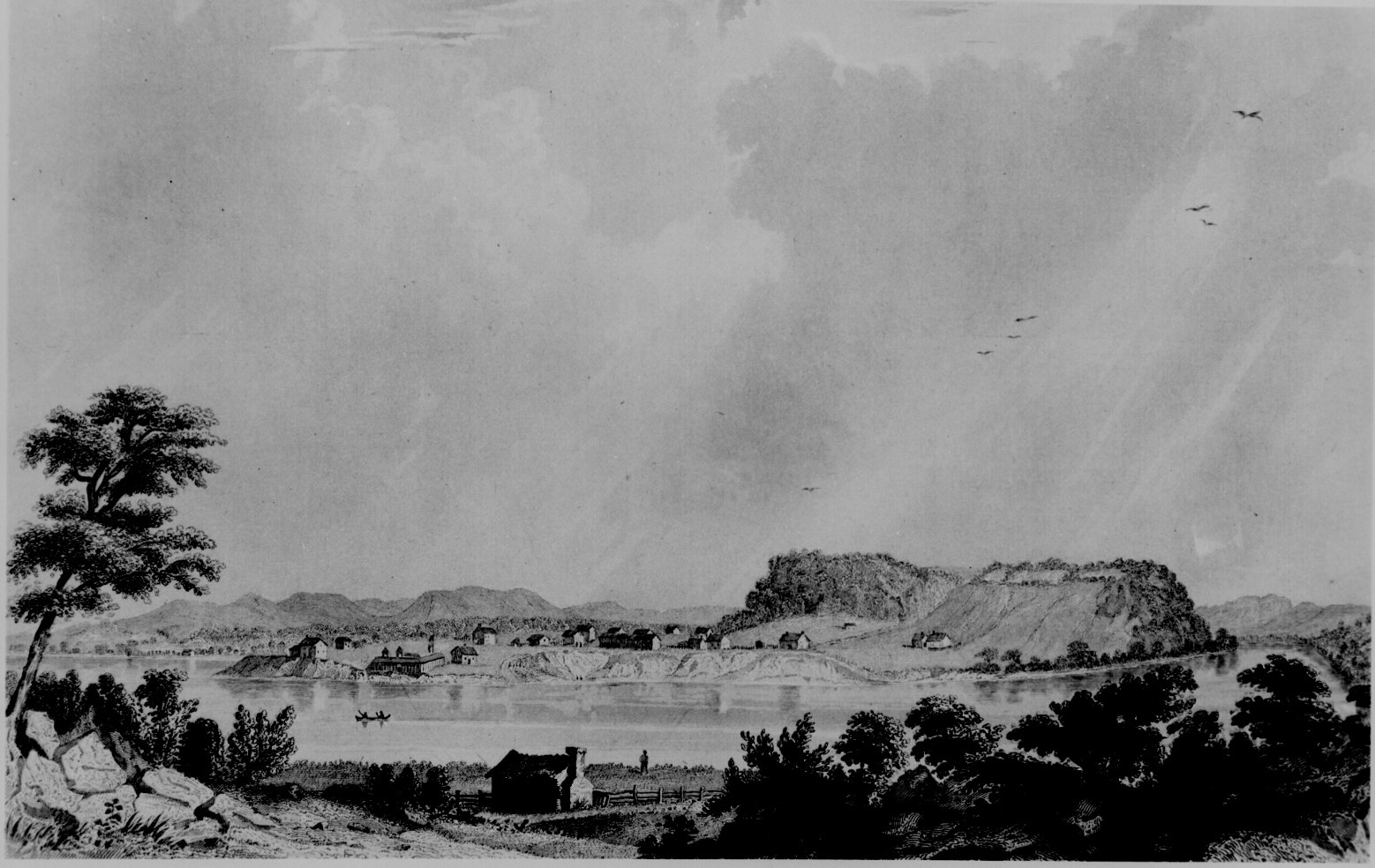 "Pittsburgh in 1790." Engraving from Information Respecting the History, Condition and Prospects of the Indian Tribes of the United States by Henry R. Schoolcraft (Philadelphia, 1854)
"Pittsburgh in 1790." Engraving from Information Respecting the History, Condition and Prospects of the Indian Tribes of the United States by Henry R. Schoolcraft (Philadelphia, 1854)
1790
The Indian Trade and Intercourse Act is passed, placing nearly all interaction between Indians and non-Indians under federal, rather than state control, established the boundaries of Indian country, protected Indian lands against non-Indian aggression, subjected trading with Indians to federal regulation, and stipulated that injuries against Indians by non-Indians was a federal crime. The conduct of Indians among themselves, while in Indian country, was left entirely to the tribes. These Acts were renewed periodically until 1834.
Military battle between US Army and Shawnee. The army, some 1,500 strong, invaded Shawnee territory, in what is now western Ohio. The Americans were defeated in 1791 after suffering 900 casualties, 600 of whom died.
On March 1, the first U.S. Census count included slave and free Negroes. Indians were not included.
Pre-1795
Trading begins between Native Americans and French and Spanish merchants from St. Louis, Missouri.
1792
On November 6, George Washington, in his fourth annual address to Congress, expressed dissatisfaction that �Indian hostilities� had not stopped in the young country�s frontier, north of the Ohio River.
1795
The Treaty of Greenville - This treaty marked the end of an undeclared and multi-tribal war begun in the late 1770s and led by the Shawnees who fought to resist American expansion into Ohio. In 1795, over a thousand Indian delegates ceded two-thirds of present-day Ohio, part of Indiana, and the sites where the modern cities of Detroit, Toledo, and Chicago are currently situated. The Indians, in return, were promised a permanent boundary between their lands and American territory.
1802
Federal law prohibits the sale of liquor to Indians.
1803
The Louisiana Purchase adds to the United States French territory from the Gulf of Mexico to the Northwest.
The Lewis and Clark expedition begins its exploration of the West.
1804 to 1806
Lewis and Clark expedition with Sacagawea. Under direction of President Jefferson, Lewis and Clark charted the western territory with the help of Sacagawea, a Shoshone Indian.
1804
The Sioux meet the Lewis and Clark Expedition
Trading posts begin to be established in the west.
Fur trading becomes an important part of Oglala life.
Oglala and other Lakota tribes expand their region of influence and control to cover most of the current regions known as North and South Dakota , westward to the Big Horn Mountains in Wyoming and south to the Platte River in Nebraska.
On March 26, the U.S. government gave first official notice to Indians to move west of the Mississippi River.
1808
The Osage, a Sioux tribe, sign the Osage Treaty ceding their lands in what is now Missouri and Arkansas to the U. S.
1808 to 1812
Tecumseh, Chief of the Shawnees, and his brother known as The Prophet, founded Prophetstown for the settlement of other Indian peoples who believed that signing treaties with the US government would culminate in the loss of the Indian way of life. At the same time, Tecumseh organized a defensive confederacy of Indian tribes of the Northwestern frontier who shared a common goal - making the Ohio River the permanent boundary between the United States and Indian land. Meanwhile, William Henry Harrison, governor or Ohio, began enacting treaties with various tribes. At a meeting between Tecumseh and Harrison at Vincennes in 1810, Tecumseh declared that he and the confederacy would never recognize any treaties signed with the US government. When Tecumseh was away from Prophetstown in November 1811, Harrison led troops to the town and after the ferocious Battle of Tippicanoe, destroyed the town as well as the remnants of Tecumseh's Indian confederacy.
1809
On February 8, Russians who built a blockhouse on the Hoh River (Olympic Penninsula, Washington) were taken captive by Hoh Indians, and were held as slaves for two years.
1810
This Treaty of Fort Wayne brought the Delawares, Potawatomi, Miami, and Eel River Miami nations together to cede 3 million acres of their land along the Wabash River to the United States.
Nicholas Biddle of the Lewis & Clark expedition noted that among the Minitaree Indians the effeminate boys were raised as females. Upon reaching puberty, the boys were then married to older men. The French called them Birdashes.
1811
On August 31, Fort Okanogan was established at the confluence of the Columbia and Okanogan Rivers; Indians met the Astorians with pledges of friendship and gifts of beaver.
On November 7, Shawnee leader Tecumseh�s dream of a pan-Indian confederation was squashed when his brother Tenskwatawa led an attack against Indiana Territory militia forces in the Battle of Tippecanoe. Tenskwatawa was defeated.
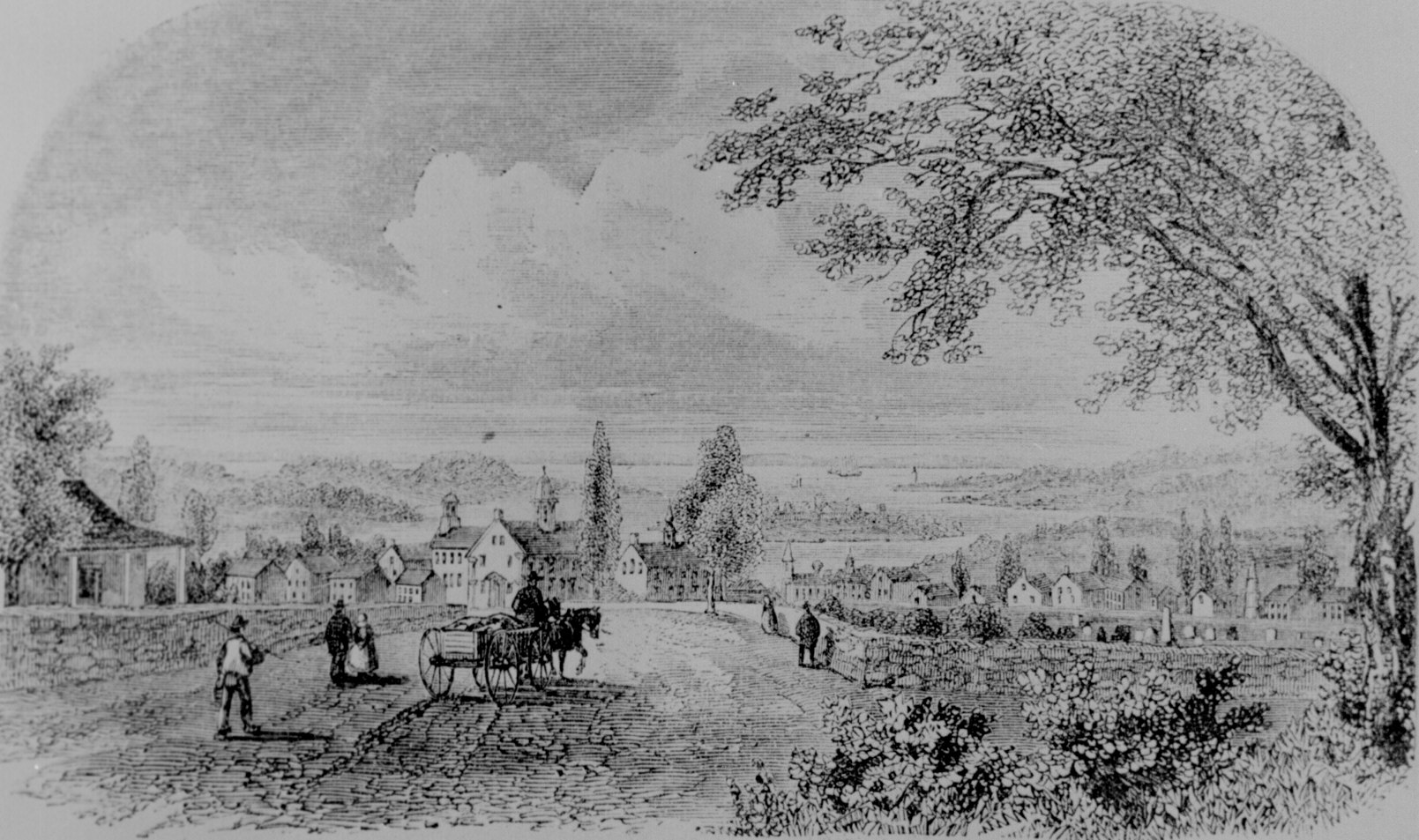 "New London [Conn.] in 1813." Engraving from "Harper's New Monthly Magazine" (Dec. 1863)
"New London [Conn.] in 1813." Engraving from "Harper's New Monthly Magazine" (Dec. 1863)
1813 to 1814
The Creek War was instigated by General Andrew Jackson who sought to end Creek resistance to ceding their land to the US government. The Creek Nation was defeated and at the Treaty of Fort Jackson, the Creek lost 14 million acres, or two-thirds of their tribal lands. To count the Creek dead, whites cut off their noses, piling 557 of them. They also skinned their bodies to tan as souvenirs. This was the single largest cession of territory ever made in the southeast.
1815
Blacks and Creek Indians captured Fort Blount, Florida from Seminoles and used it as a haven for escaped slaves and as a base for attacks on slave owners. An American army detachment eventually recaptured the fort.
On July 27, the Seminole Wars began.
1816
On July 27, Fort Blount, a Seminole fort on Apalachicola Bay, Florida, was attacked by U.S. troops. The fort, held by 300 fugitive slaves and 20 Indians, was taken after a siege of several days. The fort was destroyed, punishing the Seminoles for harboring runaway slaves.
1817
Congress passed the Indian Country Crimes Act which provided for federal jurisdiction over crimes between non-Indians and Indians, and maintained exclusive tribal jurisdiction of all Indian crimes.
1818
On April 18, Andrew Jackson defeated a force of Indians and African Americans at the Battle of Suwanee, ending the First Seminole War.
1820
By this year, more than 20,000 Indians lived in virtual slavery on the California missions.
1821
South Carolina settlers and their Cherokee allies attack and defeat the Yamassee.
The U.S. government began moving what it called the "Five Civilized Tribes" of southeast America (Cherokee, Creek, Seminole, Choctaw, and Chickasaw) to lands west of the Mississippi River.
1823
Johnson v. McIntosh Supreme Court decision - This case involved the validity of land sold by tribal chiefs to private persons in 1773 and 1775. The Court held that that Indian tribes had no power to grant lands to anyone other than the federal government. The government, in turn, held title to all Indian lands based upon the "doctrine of discovery" - the belief that initial "discovery" of lands gave title to the government responsible for the discovery. Thus, Indian "...rights to complete sovereignty, as independent nations, were necessarily diminished, and their power to dispose of the soil, at their own will, to whomsoever they pleased, was denied by the original fundamental principle, that discovery gave exclusive title to those who made it."
1824
The Indian Office federal agency was established by the Secretary of War and operated under the administration of the War Department. The Office becomes the Bureau of Indian Affairs (BIA) in 1849.
1825
Creek chief William McIntosh signs treaty ceding Creek lands to the U.S. and agrees to vacate by 1826; other Creeks repudiate the treaty and kill him.
1827
Creek Indians sign a second treaty ceding lands in western Georgia
1828
Elias Boudinot and Sequoyah begin publishing the Cherokee Phoenix, the first American newspaper published in a Native American language.
1829
Creek Indians receive orders to relocate across the Mississippi River
1830
On April 7, President Andrew Jackson submitted a bill to Congress calling for the removal of tribes in the east to lands west of the Mississippi. On May 28th, the Indian Removal Act was passed, and from 1830 to 1840 thousands of Native Americans were forcibly removed.
On September 15, the Choctaws sign a treaty exchanging 8 million acres of land east of the Mississippi for land in Oklahoma .
On December 22, the State of Georgia made it unlawful for Cherokee to meet in council, unless it is for the purpose of giving land to whites.
 La-d�o-ke-a, Buffalo Bull, a Grand Pawnee Warrior, 1832
La-d�o-ke-a, Buffalo Bull, a Grand Pawnee Warrior, 1832
1831 to 1832
Two U.S. Supreme Court cases change the nature of tribal sovereignty by ruling that Indian tribes were not foreign nations, but rather were "domestic dependent nations." As such, both cases provided the basis for the federal protection of Indian tribes, or the federal trust relationship or responsibility.
1831
Black Hawk of the Sauk and Fox tribes agrees to move west of Mississippi.
Cherokee Nation v. Georgia - The Cherokee Nation sued the State of Georgia for passing laws and enacting policies that not only limited their sovereignty, but which were forbidden in the Constitution. The Court's decision proclaimed that Indians were neither US citizens, nor independent nations, but rather were "domestic dependent nations" whose relationship to the US "resembles that of a ward to his guardian." In this case, the federal trust responsibility was discussed for the first time.
On December 6, President Andrew Jackson, in his Third Annual Message to Congress, praised the beneficial results of Indian Removal for the States directly affected and the Union as a whole, as well as being �equally advantageous to the Indians.�
On December 25, a force of Black Seminole Indians defeated U.S. troops at Okeechobee during the Second Seminole War.
1832
Worcester v. Georgia - A missionary from Vermont who was working on Cherokee territory sued the State of Georgia which had arrested him, claiming that the state had no authority over him within the boundaries of the Cherokee Nation. The Court, which ruled in Worchester's favor, held that state laws did not extend to Indian country. Such a ruling clarified that Indian tribes were under protection of the federal government, as in Cherokee v. Georgia.
On July 23, Eastern Cherokees met in Red Clay, Tennessee to discuss President Jackson's proposals for their removal to Indian Territory in present day Oklahoma . The proposal was rejected and the Cherokees refused to negotiate unless the federal government honored previous treaty promises.
On August 2, some 150 Sac and Fox men, women and children, under a flag of truce, were massacred at Bad Axe River by the Illinois militia.
1833
On January 12, a law was passed making it unlawful for any Indian to remain within the boundaries of the state of Florida
1834
Indian Intercourse Act - Congress created Indian Territory in the west that included the land area in all of present-day Kansas, most of Oklahoma , and parts of what later became Nebraska, Colorado, and Wyoming . The area was set aside for Indians who would be removed from their ancestral lands which, in turn, would be settled by non-Indians. The area steadily decreased in size until the 1870s when Indian Territory had been reduced to what is now Oklahoma , excluding the panhandle.
The Oglala Tribe becomes more centrally organized with most bands following Chief Bull Bear and rest following Chief Smoke. This was a change from their previous more loosely governed bands with many leaders of comparable influence.
1835
Treaty of New Echota - A portion of the Cherokee nation agreed to give up Cherokee lands in the Southeast in exchange for land in and removal to Indian Territory. A larger group of the Cherokee did not accept the terms of this treaty and refused to move westward.
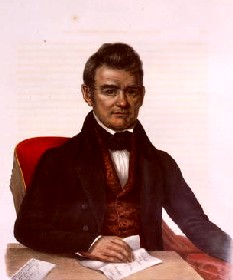 "Our Hearts are Sickened�
"Our Hearts are Sickened�
- Chief John Ross, 1836
1835-42
Seminole War - The second and most terrible of three wars between the US government and the Seminole people was also one of the longest and most expensive wars in which the US army was ever engaged. Thousands of troops were sent, 1,500 men died, and between 40-60 million dollars were spent to force most of the Seminoles to move to Indian Territory - more than the entire US government's budget for Indian Removal.
1836
In five groups, over 14,000 Creeks were forcibly removed by the US Army from Alabama to Oklahoma .
1837
Two thirds of the 6,000 Blackfeet died of smallpox
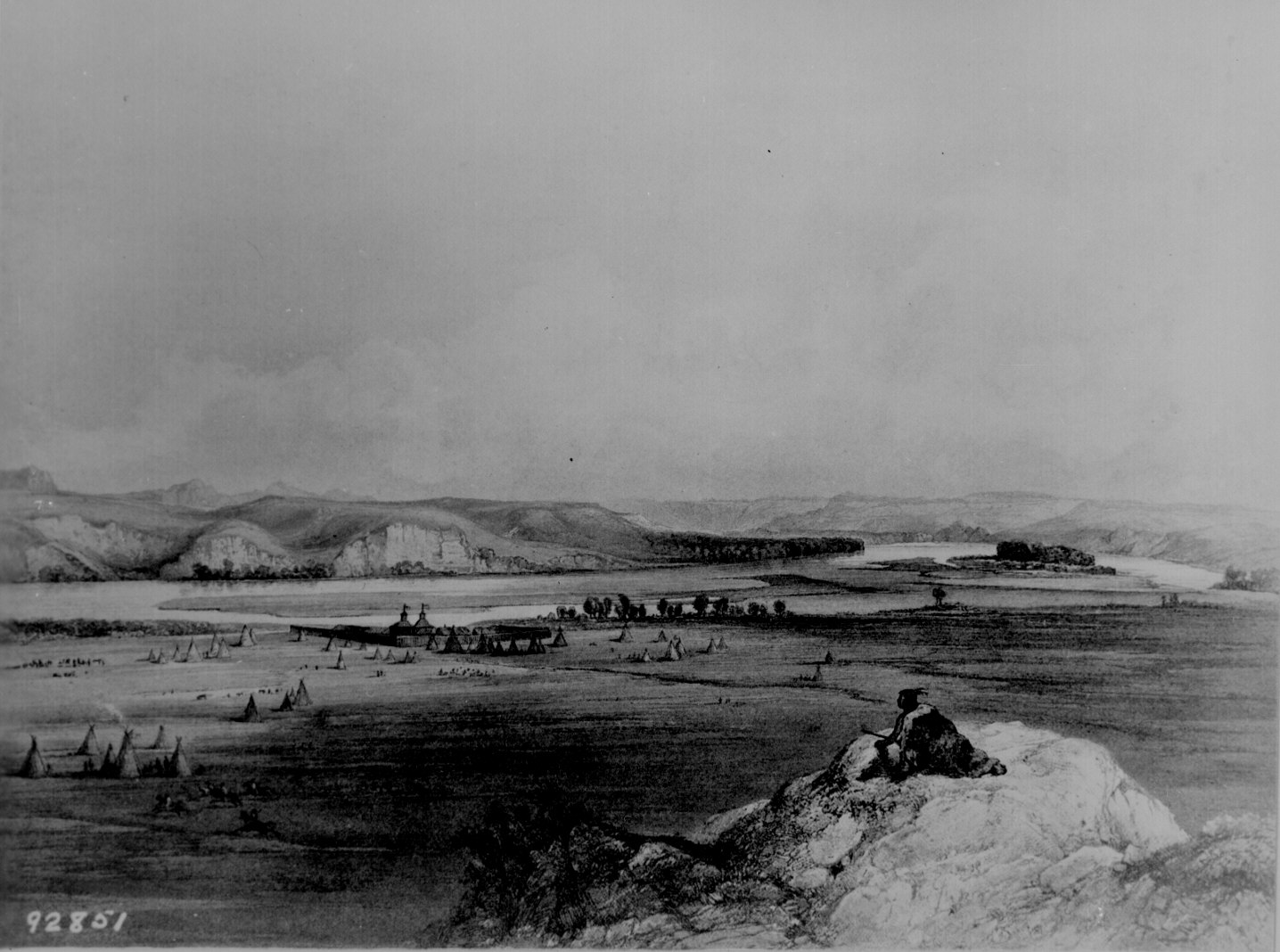
"Fort Pierre S. Dakota and the Adjacent Prairie" by Karl Bodmer - 1838-1843
1838
Trail of Tears - Despite the Supreme Court's rulings in 1831 and 1832 that the Cherokee had a right to stay on their lands, President Jackson sent federal troops to forcibly remove almost 16,000 Cherokee who had refused to move westward under the unrecognized Treaty of New Echota (1835) and had remained in Georgia. In May, American soldiers herded most into camps where they remained imprisoned throughout the summer and where at least 1,500 perished. The remainder began an 800-mile forced march to Oklahoma that fall. In all some, 4,000 Cherokee died during the removal process.
On January 30, Seminole leader Osceola died from complications of malaria at Fort Moultrie, South Carolina. He led a valiant fight against removal of his people to Indian Territory, but eventually the Seminoles were forcibly relocated.
1841
Forty-eight wagons arrive in Sacramento by way of the Oregon Trail, one of the earliest large groups to make this journey.
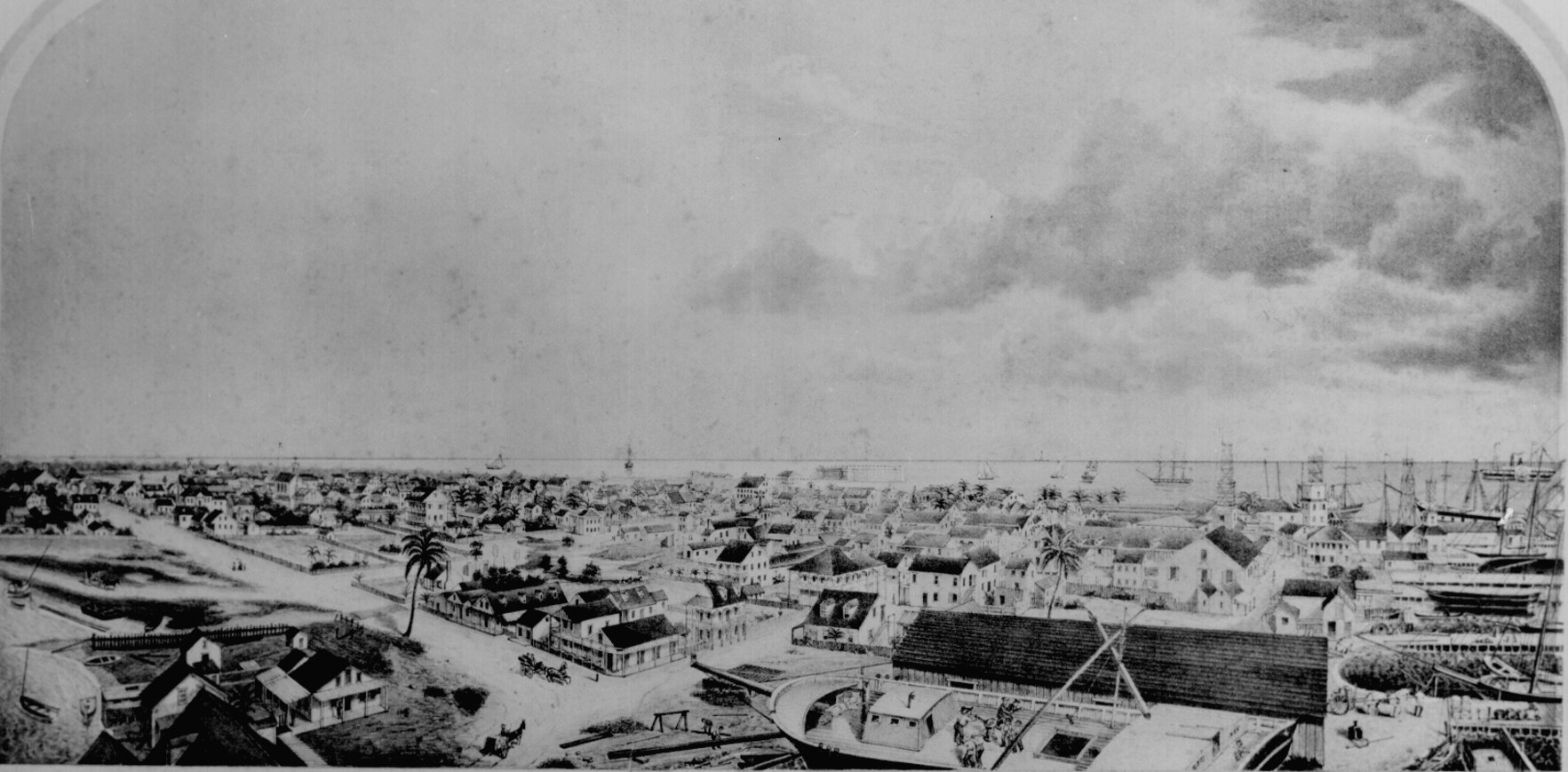
"Key West," ca. 1856. Lithograph. Chandler and Company, Boston
1842
Seminole Nation v. United States. The Court held officials of the United States were to be held to the "most exacting fiduciary standards" in performing their duties toward American Indians. Thus, it "has charged itself with moral obligations of the highest responsibility and trust" towards American Indian Nations; i.e., upholding the trust responsibility.
1843
Second Seminole War ends.
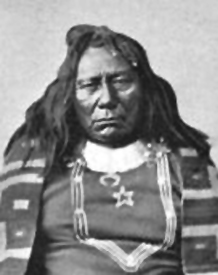 Walkara, Horse Thief and Walker War Leader
Walkara, Horse Thief and Walker War Leader
1847
Westward migration begins along the Oregon Trail through Plains Indian country.
Thomas H. Hardy, Superintendant of Indian Affairs in St. Louis warns of trouble from declining buffalo herds
1849
The U.S. Government purchases Fort Laramie from the American Fur Company and begins to bring in troops.
The Bureau of Indian Affairs (formerly The Indian Office) is transferred from the War Department to the newly-created Department of the Interior.
Physician services were extended to Indians with the establishment of a corps of civilian field employees.
January 24, 1849
James Marshall discovers gold near Sutter's Fort, California. News of the find begins the California Gold Rush of 1849.
1850
There are 20,000,000 buffalo on the plains between Montana and Texas.
On September 9, California entered the Union. With miners flooding the hillsides and devastating the land, California's Indians found themselves deprived of their traditional food sources and forced by hunger to raid the mining towns and other white settlements. Miners retaliated by hunting Indians down and brutally abusing them. The California legislature responded to the situation with an Indenture Act which established a form of legal slavery for the native peoples of the state by allowing whites to declare them vagrant and auction off their services for up to four months. The law also permitted whites to indenture Indian children, with the permission of a parent or friend, which led to widespread kidnapping of Indian children, who were then sold as "apprentices."
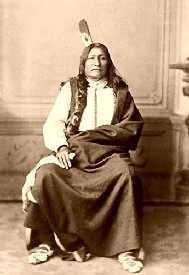 Spotted Tail, Warrior, Chief & Negotiator
Spotted Tail, Warrior, Chief & Negotiator
1850-1875
Extermination of buffalo herds by sports and hide hunters severely limits Plains Indians food supply and ability to survive.
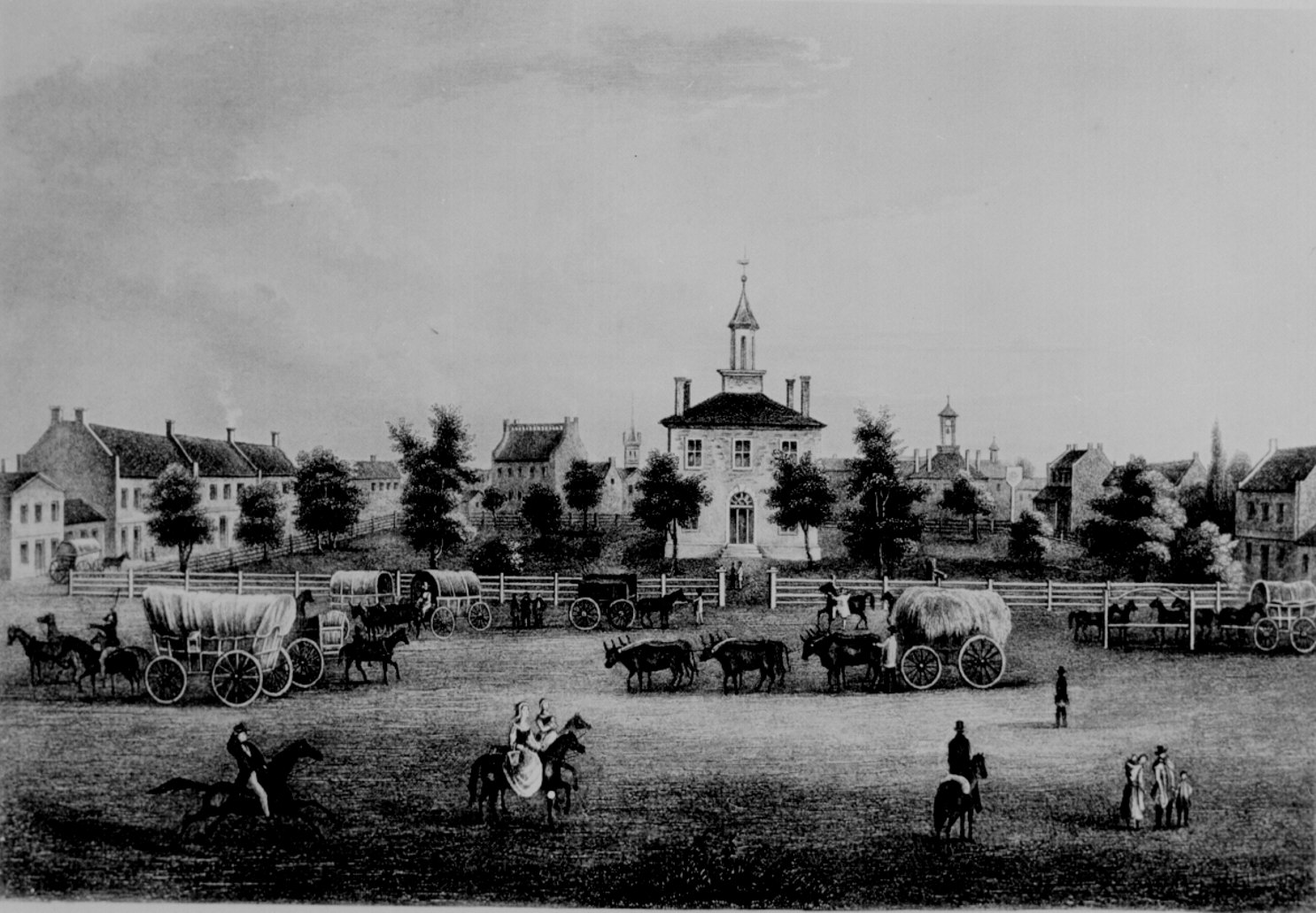
"lndependence-Courthouse-Missouri." Engraving from The United States Illustrated by Charles A. Dana (New York, 1855)
1851
A series of Fort Laramie treaties were signed with the Lakota, Cheyenne, Arapaho and other Plains tribes delineating the extent of their territories and allowing passage across these territories in exchange for payments to the tribes. The extent of Lakota territories were clearly described. Thus began the incursions of miners and wagon trains on the Oregon and later the Bozeman trails, few at first but an onslaught after the end of the Civil War.
Federal commissioners attempting to halt the brutal treatment of Indians in California negotiated eighteen treaties with various tribes and village groups, promising them 8.5 million acres of reservation lands. California politicians succeeded in having the treaties secretly rejected by Congress in 1852, leaving the native peoples of the state homeless within a hostile white society.
On August 5, 1851, Santee Sioux Chief Little Crow signed a treaty with the federal government, ceding nearly all his people's territory in Minnesota. Though not happy with the agreement, he abided by it for many years.
1853
California began confining its remaining Indian population on harsh military reservations, but the combination of legal enslavement and near genocide has already made California the site of the worst slaughter of Native Americans in United States history. As many as 150,000 Indians lived in the state before 1849; by 1870, fewer than 30,000 will remain.
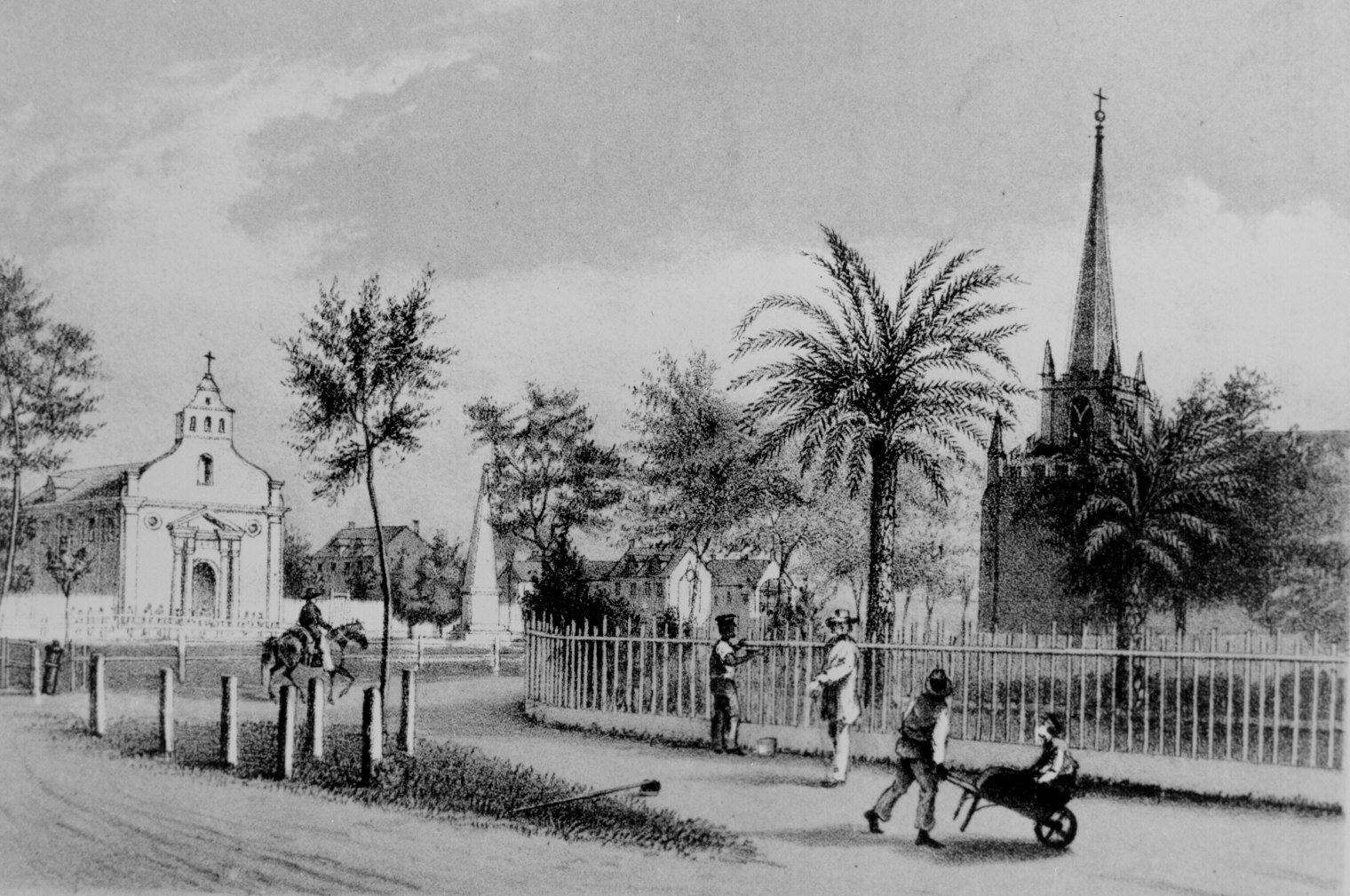 "Salt Lake City in 1850." Engraving from American Pictures Drawn with Pen and lnk by Samuel Manning (London. 1876)
"Salt Lake City in 1850." Engraving from American Pictures Drawn with Pen and lnk by Samuel Manning (London. 1876)
September 3, 1855
Ash Hollow Massacre - Colonel William Harney uses 1,300 soldiers to massacre an entire Brul� village in retribution for the killing of 30 soldiers, who were killed in retribution for the killing of the Brul� chief, Conquering Bear, in a dispute over a cow.
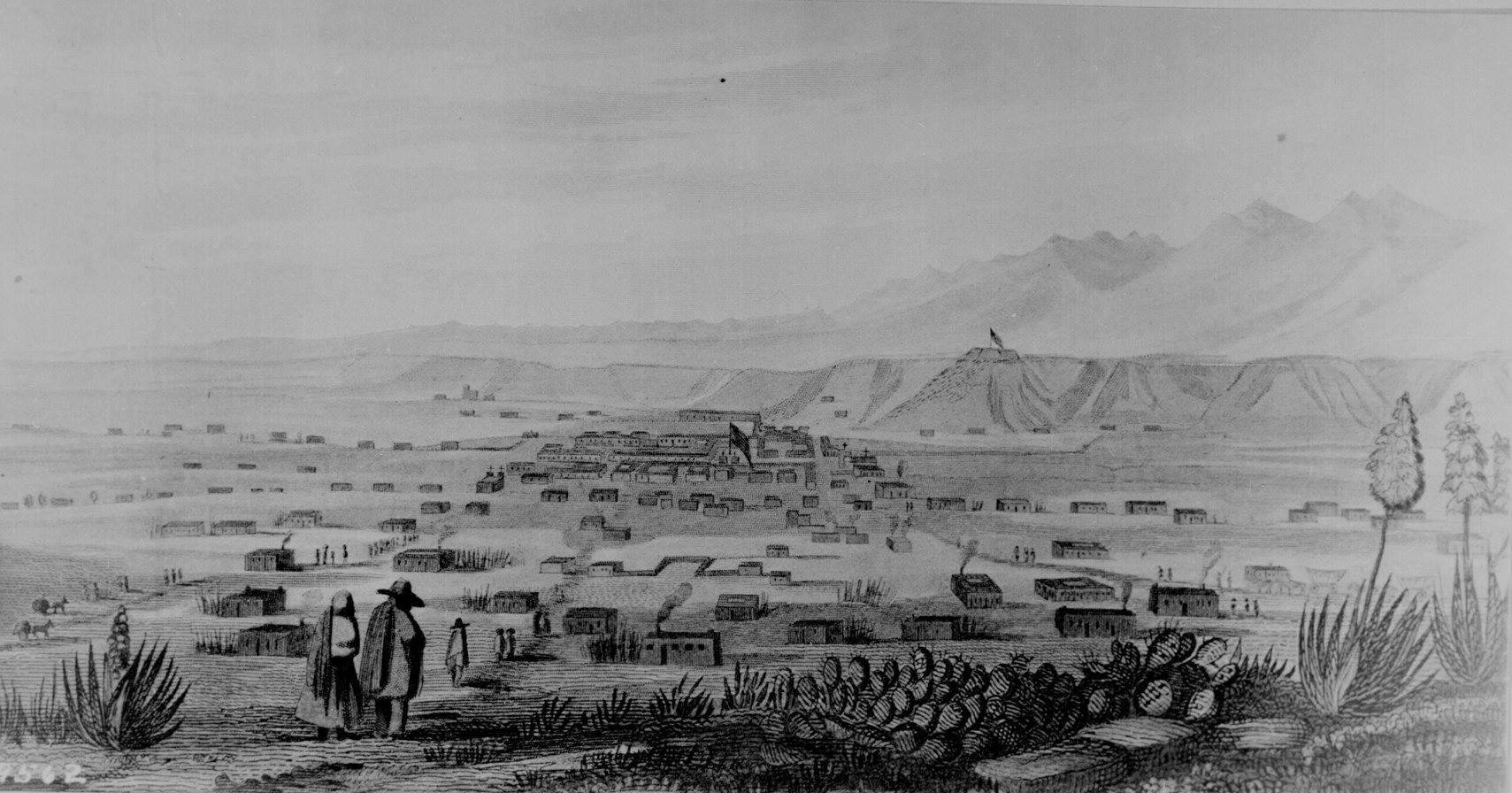 "La Ciudad de Santa Fe." Engraving frnm "Report of Lt. J. W. Abert of his Examination of New Mexico in the Years 1846-1847." S. Ex. Doc. 23, 30th Cong., 1st sess. Series 506. 111-SC-89562
"La Ciudad de Santa Fe." Engraving frnm "Report of Lt. J. W. Abert of his Examination of New Mexico in the Years 1846-1847." S. Ex. Doc. 23, 30th Cong., 1st sess. Series 506. 111-SC-89562
January 26, 1856
In the first Battle of Seattle, settlers drove Indians from their land so that a little town of white folks could prosper. The sloop Decatur fired its cannon, routing the �Indians.� Two settlers were killed.
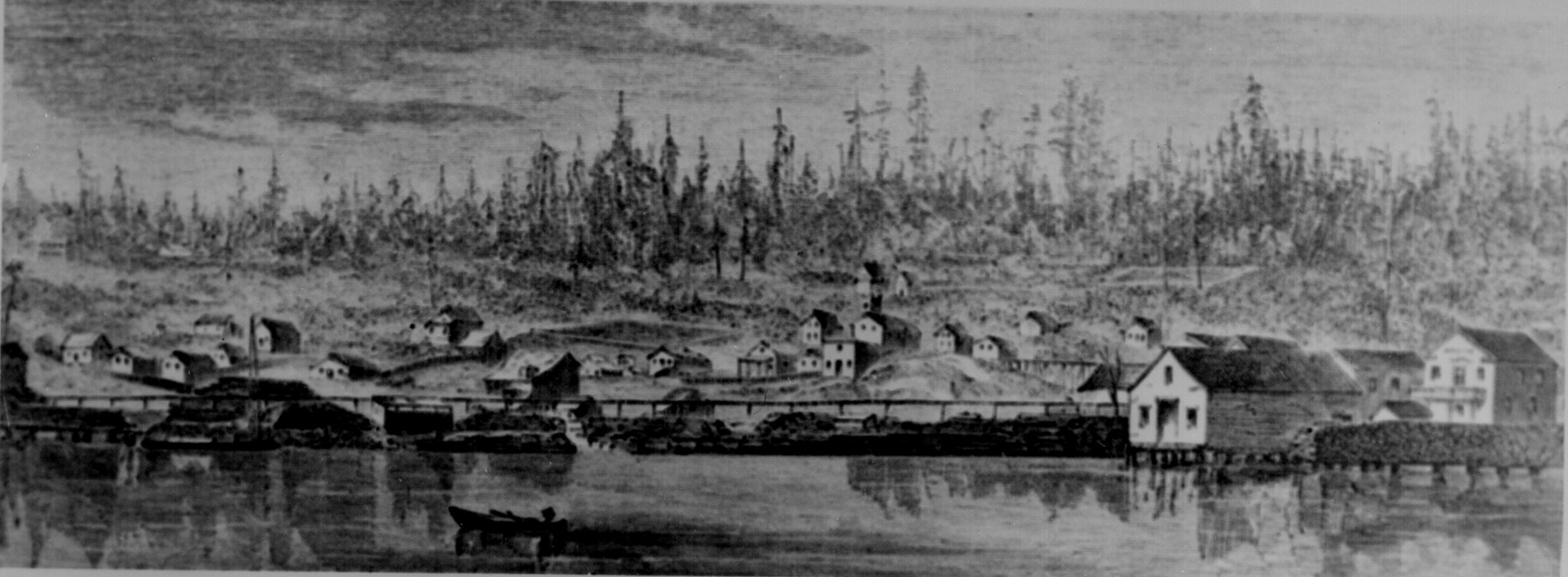 "Seattle, Washington Territory." Engraving from "Harper's New Monthly Magazine" (Sept. 1870)
"Seattle, Washington Territory." Engraving from "Harper's New Monthly Magazine" (Sept. 1870)
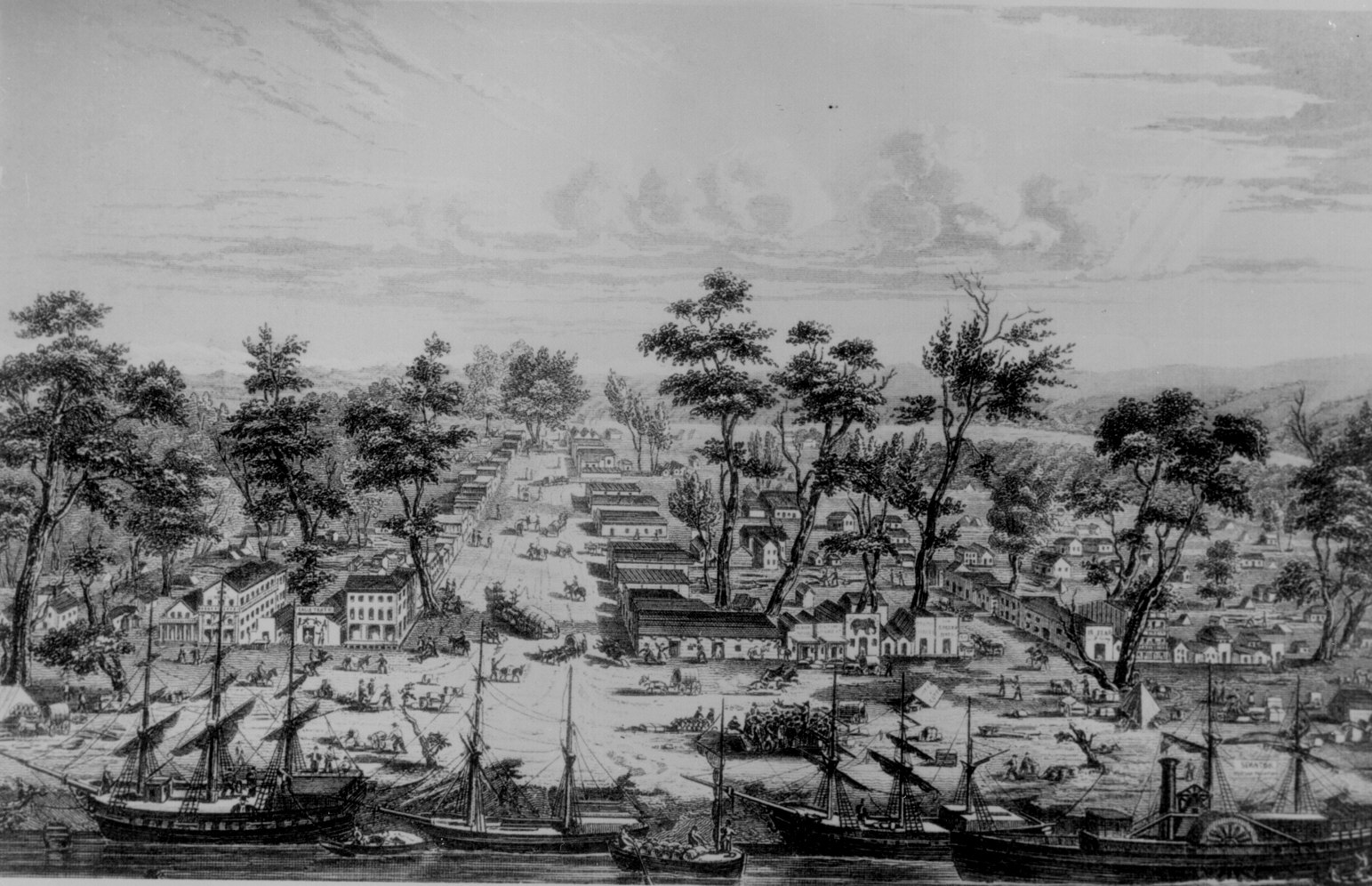 "Sacramento-City in California~" Engraving frnm The United States Illustrated by Charles A. Dana (New York, 1855)
"Sacramento-City in California~" Engraving frnm The United States Illustrated by Charles A. Dana (New York, 1855)September
1857
In September, the Fancher party, a group of California-bound emigrants from Arkansas and Missouri, arrived in Salt Lake City. According to Brigham Young�s edict, the townspeople refused to sell supplies to the group. They headed south and camped in Mountain Meadows.
On September 7, the Fancher party suffered a coordinated joint attack by Paiute Indians and Mormon militiamen. Many were killed on both sides before the pioneers could gain a tenable defensive position. Then followed five days of siege.
On September 12, the Mormons negotiated a surrender. The local Mormon leader, John Doyle Lee, and 54 Mormon militiamen approached the Fancher party and offered to provide safe passage through the territory. The surviving members of the Fancher party would hand over their livestock to the Paiutes and their guns to the Mormons. In return, the pioneers were guaranteed safe passage from the area. Once the emigrants accepted the Mormon offer and laid down their weapons, the Mormons opened fire on them. The Paiute, allies of the Mormons, stormed the wagon train, and slaughtered the women and all the older children. When the bloodbath ended, 123 were dead; only 17 young children were left alive. Lee fled the area with his 17 wives and settled in Lee's Ferry, Arizona.
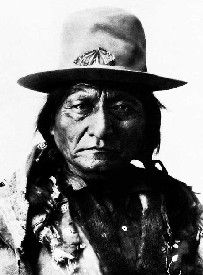 Sitting Bull, Lakota Chief and Holy Man
Sitting Bull, Lakota Chief and Holy Man
In 1877, Lee was arrested and tried for his part in the massacre. He was convicted and sentenced to die. On March 23, Lee was brought to Mountain Meadows, where he sat blindfolded on the coffin that was to hold his remains and was executed by a firing squad.
1858
On May 17, 1,200 Coeur d'Alene, Palouse, Spokane, and Skitswich Indians defeated a strong force of Colonel Steptoe near Colfax, Washington , at the village of To-ho-to-nim-me.
On September 17, Colonel Wright dictated terms of surrender to Indians at Coeur d'Alene mission. 24 chiefs of the Yakama, Cayuse, Wallawalla, Palouse and Spokane tribes were shot or hanged.
1860
On February 26, white settlers from Eureka, California attacked and killed 188 members of the Wiyot Tribe on Indian Island in Humboldt Bay. Only one Wiyot member survived � a child named Jerry James, who was the son of chief Captain Jim.
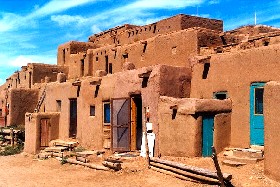 Taos Pueblo
Taos Pueblo
On April 29, Navajo Chief Manuelito and his warriors attacked Fort Defiance in northeastern Arizona. The fort, the first built in Navajo country, was near livestock grazing land used by the Navajo. Conflict began when the army claimed the grazing land for their horses.
1860 to 1864
The Navajo War broke out in the New Mexico Territory as a result of tensions between the Navajos and American military forces in the area. During a final standoff in January 1864 at Canyon de Chelly, fears of harsh winter conditions and starvation forced the Navajo to surrender to Kit Carson and his troops. Carson ordered the destruction of Navajo property and organized the Navajo Long Walk to Bosque Redondo reservation at Fort Sumner, New Mexico .
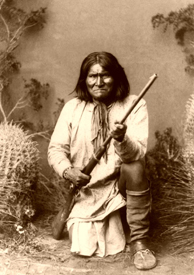 Geronimo in 1886
Geronimo in 1886
1861
On February 13, the first military action to result in the Congressional Medal of Honor occurred. Colonel Bernard Irwin attacked and defeated hostile Chiricahua Indians in Arizona.
On February 18, Arapaho and Cheyenne ceded most of eastern Colorado , which had been guaranteed to them forever in an 1851 treaty.
On September 22, in an unprovoked peacetime attack, U.S. Army soldiers massacred visiting Navajo men, women and children during a horse race at Fort Wingate, New Mexico .
 Apache Before the Storm
Apache Before the Storm
On September 22, 500 Apaches led by Cochise attacked the town of Pinos Altos, New Mexico. Three miners and 14 Indians were killed.
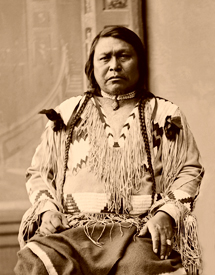 Chief Ouray, between 1865 and 1880
Chief Ouray, between 1865 and 1880
1862
Congress passes the Homestead Act making western lands belonging to many Indian Nations available to non-Indian American settlers. This marked the beginning of mass migrations to Indian lands for non-Indian settlement.
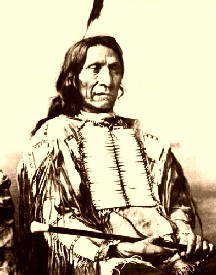 Chief Red Cloud, Lakota Sioux
Chief Red Cloud, Lakota Sioux
August 18, 1862
Spotted Tail, is assassinated by Crow Dog - White officials dismiss the killing as a simple quarrel, but the Sioux feel that it was the result of a plot to wrest control from a strong Indian leader.
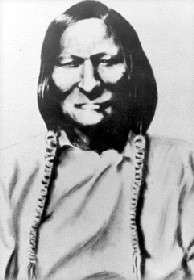 Motavato (Black Kettle) speaking to Colorado Govornor Evans, Colonel Chivington, Major Wynkoop & others in Denver, autumn, 1864
Motavato (Black Kettle) speaking to Colorado Govornor Evans, Colonel Chivington, Major Wynkoop & others in Denver, autumn, 1864
1882
Congressional Act - Congress provided funds for the mandatory education of 100 Indian pupils in industrial schools and for the appointment of an Inspector or Superintendent of Indian schools.
Indian Rights Association - This organization was created to protect the interests and rights of Indians. The association was composed of white reformers who wanted to help Indians abandon their cultural and spiritual beliefs and assimilate into American society.
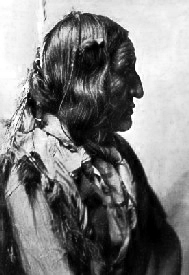 Little Wolf - Courageous Leader of the Cheyennes
Little Wolf - Courageous Leader of the Cheyennes
On October 24, a federal Grand Jury in Arizona charged civil authorities with mismanagement of Indian Affairs on the San Carlos Reservation.
1883
Ex Parte Crow Dog Supreme Court decision. - Crow Dog, a Sioux Indian who shot an killed an Indian on the Rosebud Reservation, was prosecuted in federal court, found guilty, and sentenced to death. On appeal it was argued that the federal government's prosecution had infringed upon tribal sovereignty. The Court ruled that the US did not have jurisdiction and that Crow Dog must be released. The decision was a reaffirmation of tribal sovereignty and led to the passage of the 1885 Major Crimes Act which identified seven major crimes, that if committed by an Indian on Indian land, were placed within federal jurisdiction.
A group of clergymen, government officials and social reformers calling itself �The Friends of the Indian� met in upstate New York to develop a strategy for bringing Native Americans into the mainstream of American life. Their decisions set the course for U.S. policy toward Native Americans over the next generation and resulted in the near destruction of native American cultures.
Courts of Indian Offenses - The Secretary of the Interior established these courts to uphold the 1880 Civilization Regulations to eliminate "heathenish practices" among the Indians. The rules of the courts forbade the practice of all public and private religious activities by Indians on their reservations, including ceremonial dances, like the Sun Dance, and the practices of "so-called medicine men."
In May, Lakota Chief Sitting Bull was released from prison. He rejoined his tribe in Standing Rock where he was forced to work the fields. He spoke forcefully against plans to open part of the reservation to White settlers. Despite the old chief's objections, the land transfer proceeded as planned. He lived the rest of his life across the Grand River from his birthplace.
On September 8, Sitting Bull delivered a speech, at the celebration of the driving of the last spike in the transcontinental railroad system, to great applause. He delivered the speech in his Sioux language, departing from a speech originally prepared by an army translator. Denouncing the U.S. government, settlers, and army, the listeners thought he was welcoming and praising them. While giving the speech, Sitting Bull paused for applause periodically, bowed, smiled, and continued insulting his audience as the translator delivered the original address.
On November 3, the U.S. Supreme Court ruled that an Indian is by birth "an alien and a dependent."
1885
Sitting Bull tours with Buffalo Bill's Wild West Show.
Major Crimes Act - This Congressional Act gave federal courts jurisdiction over Indians accused of rape, manslaughter, murder, assault with intent to kill, arson, or larceny against another Indian on a reservation. The list was eventually expanded to include 14 crimes.
When U.S. troops pursued a band of Apaches near Pleasanton, New Mexico , the Indians caught the soldiers in a triple cross-fire trap and killed them all.
1886
United States v. Kagama Supreme Court decision. Two Indians on the Hoopa Valley Reservation in northern California killed another Indian on the reservation. They were prosecuted and found guilty by the federal government. The Indians argued that Congress did not have constitutional authority to pass the Major Crimes Act (1885). The Court, however, upheld the full and absolute (plenary) power of the Congress to pass the Major Crimes Act and of the federal government - not state governments - exclusively to deal with Indian tribes. "These Indian tribes are the wards of the nation. They are communities dependent on the United States - dependent largely for their daily food; dependent for their political rights. They owe no allegiance to the states, and receive from them no protection. Because of the local ill feeling, the people of the states where they are found are often their deadliest enemies. From their very weakness and helplessness, so largely due to the course of dealing of the federal government with them, and the treaties in which it has been promised, there arises the duty of protection, and with it the power." Thus, the case challenged the major crime act and its ruling upheld it by implying that because Indian tribes were wards of the US, Congress had the power to regulate tribes, even if it interfered with their sovereign power to deal with criminal offenders on tribal lands.
Geronimo, described by one follower as �the most intelligent and resourceful . . most vigorous and farsighted� of the Apache leaders, surrendered to General Nelson A. Miles in Skeleton Canyon, Arizona, after more than a decade of guerilla warfare against American and Mexican settlers in the Southwest. The terms of surrender required Geronimo and his tribe to settle in Florida, where the Army hoped he could be contained.
1887
The Dawes Severalty Act, otherwise known as the General Allotment Act, gives the President power to reduce the landholdings of the Indian nations across the country by allotting 160 acres to the heads of Indian families and 80 acres to individuals. The "surplus lands" on the reservations were opened up to settlement.
On July 16, J. D. C. Atkins, the Commissioner of Indian Affairs, wrote in his annual report that English would be the exclusive language used at all Indian schools. He argued that native languages were not only of no use, but were detrimental to the education and civilization of Indians.
1888
Oglala Lakota move to Pine Ridge Agency on South Dakota /Nebraska border.
The Sioux Act - This Congressional Act divided the Great Sioux Reservation into six separate reservations in an effort to dilute their power and make much of their land available for non-Indian settlement.
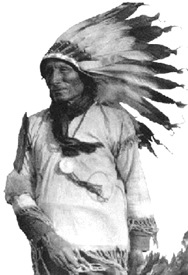 Wovoka, Paiute Medicine Man & the Ghost Dance
Wovoka, Paiute Medicine Man & the Ghost Dance
1889
The Sioux sign an agreement with the U.S. government breaking up the great Sioux Reservation. The Sioux will get six separate small reservations. The major part of their land was thrown open to settlers.
Oklahoma Organic Act - This Congressional Act divided Indian land into two territories in what is currently the state of Oklahoma : the Territory of Oklahoma in western Oklahoma was opened up to non-Indian settlement; and the Indian Territory in eastern Oklahoma was retained for continued Indian settlement.
Two Zuni Indians were hanged over the wall of a Spanish church in Arizona on the charge of using witchcraft to chase away rain clouds.
January 1, 1889
A Paiute rancher named Wovoka announced that he had dreamed a vision of a new world set aside for native people and that white people would vanish en masse. It was the birth of the short-lived Ghost Dance religion.
February 19, 1889
The Quileut Indian reservation at La Push, Washington was established.
April 22, 1889
In the first " Oklahoma Land Rush," the U.S. government bows to pressure and opens for settlement land that it had previously promised would be a permanent refuge for Native Americans moved from their eastern territories. Native American tribes are paid about $4 million for the parcel of land. The starting gun sounds at noon, and an estimated 50,000 settlers race across the land; by sunset, all 1.92 million acres have been claimed.
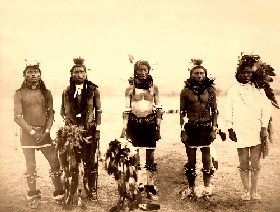 Cheyenne dancers, 1890
Cheyenne dancers, 1890
1890
Congress established the Oklahoma Territory on unoccupied lands in the Indian Territory , breaking a 60-year-old pledge to preserve this area exclusively for Native Americans forced from their lands in the east.
May 29, 1890
Charles L. Hyde, a Pierre, South Dakota citizen, wrote a letter to the Secretary of the Interior saying the Ghost Dance was leading to a possible uprising by the Sioux. Prior to the letter, federal agents were not concerned about the Ghost Dance, but soon after, they feared the ceremony.
October 16, 1890
Reservation Police forcibly removed Kicking Bear from Standing Rock Agency, South Dakota , for teaching the Ghost Dance, a visionary ceremony foretelling the disappearance of white people.
December 15, 1890
When Federal troops tried to arrest Sioux Indians in Little Eagle, South Dakota on December 15, Chief Sitting Bull ordered his warriors to resist and he was shot in the back of the head and killed. The aftermath of his death led to the massacre of the Sioux at Wounded Knee.
December 29, 1890
Big Foot's band of Minneconjous try to reach Pine Ridge and the protection of Red Cloud after hearing of Sitting Bull's death. Also present were members of the Sioux band led by Chief Spotted Elk. Hungry and exhausted, they had assembled under armed guard as requested to receive the protection of the Government of the United States of America, surrendering their arms and submitting to a forced search of tents and teepees that yielded but two remaining rifles. Marched to Wounded Knee Creek, South Dakota , they were disarmed by the U.S. Army. A group of 120 men and 230 women and children were counted by Major Samuel Whitside at sundown on December 28, 1890. The next day an unidentified shot rang out and the well-armed 487 U.S. soldiers ringing the defenseless people opened fire. Afterwards, 256 Sioux lay dead and were buried in mass graves. Twenty (20) Congressional Medals of Honor were awarded the soldiers.
1891
Indian Education - A Congressional Act authorized the Commissioner of Indian Affairs "to make and enforce by proper means" rules and regulations to ensure that Indian children attended schools designed and administered by non-Indians.
Amendment to the Dawes Act - This amendment modified the amount of land to be allotted and set conditions for leasing allotments.
1893
Indian Education - This Congressional Act made school attendance for Indian children compulsory and authorized the BIA to withhold rations and government annuities to parents who did not send their children to school.
Experts estimated that fewer that 2,000 buffalo remained of the more than 20 million that once roamed the Western plains.
More than 100,000 white settlers rushed into Oklahoma's Cherokee Outlet to claim six million acres of former Cherokee land.
On February 10, the Campo Indian Reservation near San Diego was established for the Campo band of Kumeyaay Indians. The tribe that had dwindled down to 200 members, from 2000 forty years earlier, was given one acre of land.
1894
On January 8, the Yakama signed away 23,000 acres of timberland formerly inhabited by the Wenatchee tribe to the U.S. for $20,000.
Jan-August, 1895
Chief Lomahongyoma and eighteen other Hopi Indians were placed in Alcatraz for their resistance to government attempts to erase the Hopi culture. The nineteen Hopi were jailed for their resistance to farm on individual plots away from the mesas and for refusing to send their children to government boarding schools.
1898
Curtis Act - This Congressional Act ended tribal governments practice of refusing allotments and mandated the allotment of tribal lands in Indian Territory - including the lands of the Cherokee, Creek, Choctaw, Chickasaw, and Seminole nations.
1899
On March 2, Congress allowed railroad companies blanket approval for rights-of-way through Indian lands.
 Ball-play of the Choctaw�Ball up, 1846�50, Choctaw
Ball-play of the Choctaw�Ball up, 1846�50, Choctaw
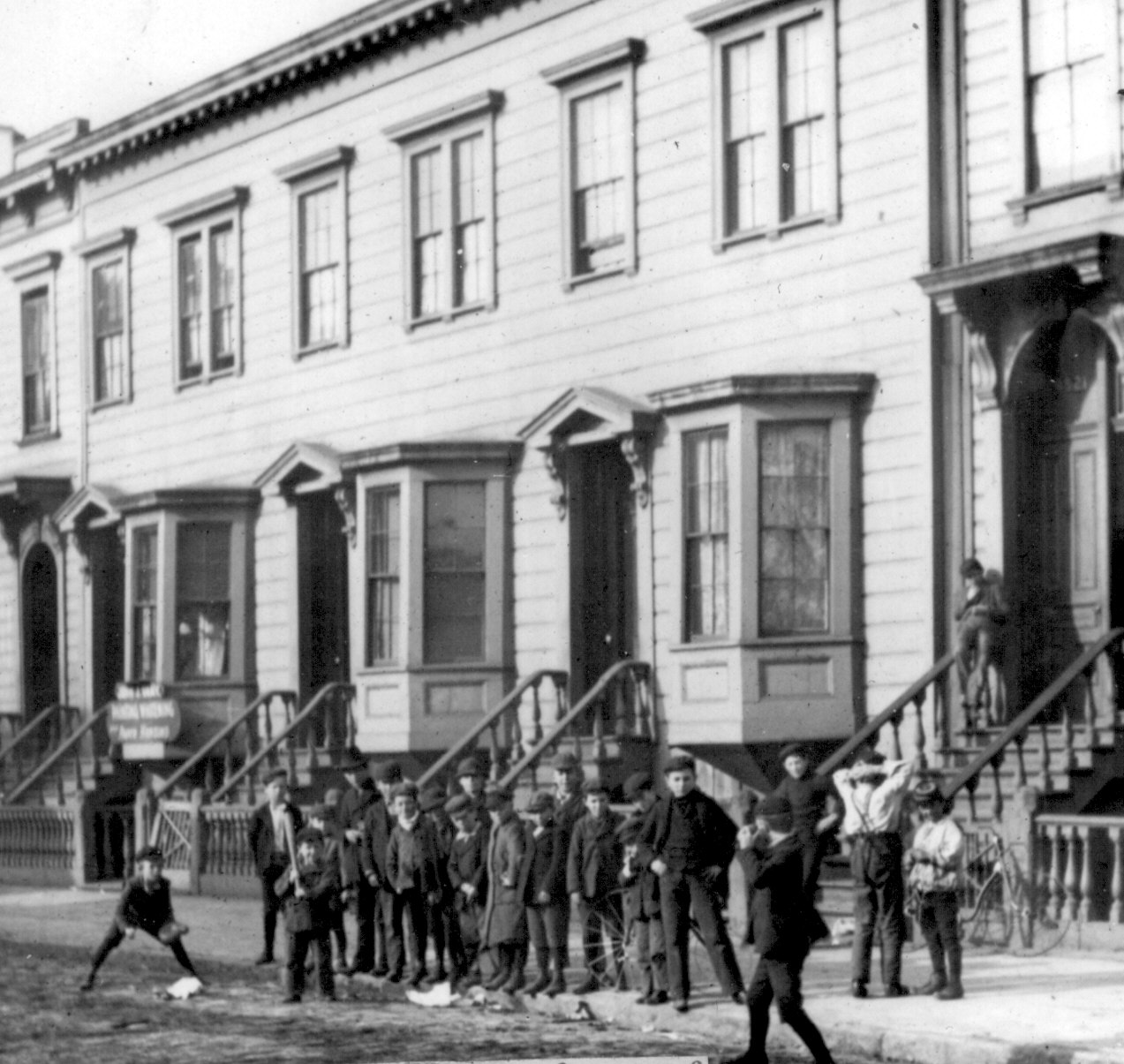 Children play ball in the street in front of typical housing with five rooms per family for $10 to $12 per month. San Francisco, ca. 1900.
Children play ball in the street in front of typical housing with five rooms per family for $10 to $12 per month. San Francisco, ca. 1900.
1903
Lone Wolf vs. Hickcock Supreme Court decision - The Kiowas and Comanches sued the Secretary of the Interior to stop the transfer of their lands without consent of tribal members which violated the promises made in the 1867 Treaty of Medicine Lodge. The Court ruled that the trust relationship served as a source of power for Congress to take action on tribal land held under the terms of a treaty. Thus, Congress could, by statute, abrogate the provisions of an Indian treaty. Further, Congress had a plenary - or absolute - power over tribal relations.
1906
Antiquities Act - This Congressional Act declared that Indian bones and objects found on federal land were the property of the United States.
Burke Act - This act amended the Dawes Act to give the secretary of the interior the power to remove allotments from trust before the time set by the Dawes Act, by declaring that the holders had "adopted the habits of civilized life." This act also changed the point at which the government would award citizenship from the granting of the allotment to the granting of the title.
1907
State of Oklahoma - Congress established the State of Oklahoma by merging Oklahoma Territory and Indian Territory. The former Indian Territory was opened to additional non-Indian settlement.
1908
Winters v. United States Supreme Court decision. Indians from the Fort Belknap reservation in Montana sued to prevent a white settler from damming the Milk River and diverting water from their reservation. The Court found that when Congress created reservations, it did so with the implicit intention that Indians should have enough water to live. Thus, Indians had federally reserved and protected water rights.
1910
Act to Provide for Determining the Heirs of Deceased Indians ("and other purposes"). This act altered the Dawes Act by dealing with inheritance and leasing of allotments and with the allotment of land that could be used for irrigated farming, among many other things.
1911
Society of American Indians - The Society - the first step in the direction of pan-Indian unity - was established and managed exclusively by American Indians, most of whom were well-known in non-Indian society and well-educated. Although members favored assimilation, they also lobbied for many reform issues, especially improved health care on reservations, citizenship, and a special court of claims for Indians.
1913
US v. Sandoval Supreme Court decision. The Court upheld the application of a federal liquor-control law to the New Mexico Pueblos, even though Pueblo lands had never been designated by the federal government as reservation land. The Court ruled that an unbroken line of federal legislative, executive, and judicial actions had "...attributed to the United States as a superior and civilized nation the power and duty of exercising a fostering care and protection over all dependent Indian communities within its borders..." Thus, once Congress had begun to act in a guardian role toward the tribes, it was up to Congress, not the courts, to determine when the state of wardship should end.
1917
World War I - When the US entered the war, about 17,000 Indians served in the armed forces. Some Indians, however, specifically resisted the draft because they were not citizens and could not vote or because they felt it would be an infringement of their tribal sovereignty. In 1919, Indian veterans of the war were granted citizenship.
1918
Native American Church - This Indian church was organized in Oklahoma to combine an ancient Indian practice - the use of peyote - with Christian beliefs of morality and self-respect. The Church prohibits alcohol, requires monogamy and family responsibility, and promotes hard work. By 1923, 14 states had outlawed the use of peyote and in 1940, the Navajo tribal council banned it from the reservation. In1944, the Native American Church of the United States was incorporated. Today, the Church continues to play an important role in the lives of many Indian people.
1924
Indian Citizenship Act - This Congressional Act extended citizenship and voting rights to all American Indians. Some Indians, however, did not want to become US citizens, preferring to maintain only their tribal membership.
1924
Indian Health Division - Congress established the Division to operate under the jurisdiction of the Bureau of Indian Affairs.
1928
The Meriam Report "The Problem of Indian Administration." - The report, commissioned by the Department of Interior in 1926, focused on the poverty, ill health, and despair that characterized many Indian communities. It recommended reforms that would increase the BIA's efficiency, and promote the social and economic advancement of Indians: the termination of allotment and the phasing out of Indian boarding schools.
1934
The Indian New Deal - The brainchild of BIA director John Collier, the New Deal was an attempt to promote the revitalization of Indian cultural, lingual, governmental, and spiritual traditions. This blueprint for reform was written by non-Indians who felt they knew how to champion Indian rights.
Johnson-O'Malley Act - This Congressional Act stipulated that the federal government was to pay states between 35 and 50 cents per day for Indian children enrolled in schools.
Indian Reorganization Act (IRA) - The IRA was the centerpiece of the Indian New Deal. It encouraged Indians to "recover" their cultural heritage, prohibited new allotments and extended the trust period for existing allotments, and sought to promote tribal self-government by encouraging tribes to adopt constitutions and form federally-chartered corporations. In order to take advantage of IRA funding, tribes were required to adopt a U.S. style constitution. Tribes were given two years to accept or reject the IRA. Tribes who accepted it could then elect a tribal council. 174 tribes accepted it, 135 which drafted tribal constitutions. However, 78 tribes rejected the IRA, most fearing the consequences of even further federal direction.
1941
World War II - During the course of the war, about 25,000 American Indians served in the armed forces; another 40,000 Indian men and women were employed in wartime industries. Key among the American Indians participating in WWII were the Navajo and Comanche Code Talkers.
1942
On January 9, a U.S. government press release said 40 percent more Native Americans have enlisted to fight in WWII than have been drafted. Altogether, 25,000 Indians served in the U.S. armed forces, including 800 women. In the Philippines, a Choctaw scout escaped from the Japanese at the battle of Corregidor, and led underground guerrilla forces until the war ended. The Oneidas, Chippewas, and Comanches blocked Japanese decoding of military information by dispatching messages in their tribal languages. Navajo Code Talkers were instrumental in the landing at Guadalcanal, where they sent and received reports from field commanders.
1944
National Congress of American Indians (NCAI) - About 100 Indian People met to create the nation�s first large-scale national organization designed to monitor federal policies. Today, over 250 member tribes throughout the US work to secure for Indian People and their descendants the rights and benefits to which they are entitled; to enlighten the public toward the better understanding of Indian people; to preserve rights under Indian treaties or agreements with the United States; and to promote the common welfare of the American Indians and Alaska Natives.
1946
Indian Claims Commission Act - The Commission was created to do away with tribal grievances over treaty enforcement, resource management, and disputes between tribes and the US government. Tribes were given five years to file a claim, during which them they had to prove aboriginal title to the lands in question and then bring suit for settlement. The Commission would then review the case and assess the amount, if any, that was to be paid in compensation. Until the Commission ended operations in 1978, it settled 285 cases and paid more than $800 million in settlements.
1948
Trujillo v. Garley Supreme Court decision - In response to the allegation that many states had successfully prohibited Indians from voting, the Court ruled that states were required to grant Native Americans the right to vote.
1953
Termination - Under House Concurrent Resolution 108, the trust relationship with many Indian tribes was terminated. Terminated tribes were then subject to state laws and their lands were sold to non-Indians. Eventually, Congress terminated over 100 tribes, most of which were small and consisted of a few hundred members as most. The Menominee of Wisconsin and the Klamath of Oregon were exceptions with 3,270 and 2,133 members respectively.
1953
Public Law 280 - This Congressional law transferred jurisdiction over most tribal lands to state governments in California, Oregon , Nebraska, Minnesota, and Wisconsin. Alaska was added in 1958. Additionally, it provided that any other state could assume such jurisdiction by passing a law or amending the state's constitution.
1953
Relocation - In order to deal with increasing unemployment among American Indians, the BIA enacted a new policy to persuade large numbers of Indians to relocate into urban areas. Using the lure of job training and housing, brochures depicting Indian families leading a middle-class life were distributed by the BIA. While the initial response was enthusiastic, within five years the relocation program was counted a failure, with 50 percent of the participants returning to their reservations. This was the first of many late 20th Century failures to "mainstream" the Indian population.
1954
Public Law 83-568 - This Congressional law transferred responsibility for American Indians and Alaskan Natives' health care from the BIA in the Department of Interior, to the Public Health Services within the Department of Health and Human Services.
1961
National Indian Youth Council (NIYC) - This organization sought, and still seeks, to resurrect a sense of national pride among young Indian people and to instill an activist message - Indians were no longer to bow their heads in humble obedience to the BIA and other institutions of white society. Instead, they were to look back to their own great cultural traditions and make decisions about their lives based upon such traditions.
1965-1973
Vietnam War - At least 43,000 American Indians fought in the Vietnam War.
1968
Indian Civil Rights Act (ICRA) - This Congressional Act revised Public Law 280 by requiring states to obtain tribal consent prior to extend any legal jurisdiction over an Indian reservation. It also gave most protections of the Bill of Rights and the Fourteenth Amendment to tribal members in dealings with their tribal governments. ICRA also amended the Major Crimes Act to include assault resulting in serious bodily harm.
American Indian Movement (AIM) - Shortly after the Minneapolis Anishinaabeg formed an "Indian Patrol" to monitor police activities in Indian neighborhoods, AIM was co-founded by Dennis Banks. The new organization was comprised primarily of young urban Indians who believed that direct and militant confrontation with the US government was the only way to redress historical grievances and to gain contemporary civil rights; and that the tribal governments organized under the IRA (1934) were not truly legitimate or grounded in traditional Indian ways. By the 1990s, AIM was still active in Indian affairs, but was less involved in militant confrontation.
1969
"Indians of All Tribes" occupation of Alcatraz - A group of young Indians seized the abandoned Alcatraz Island in the San Francisco harbor. They issued a "Proclamation to the Great White Father" in which they stated their claim that Alcatraz was suitable as an Indian Reservation and thus, should be converted into an Indian educational and cultural center. The Indians of All Tribes continued to occupy AAlcatraz until June, 1971.
1970
Nixon's "Special Message on Indian Affairs" - President Nixon delivered a speech to Congress which denounced past federal policies, formally ended the termination policy, and called for a new era of self-determination for Indian peoples.
1972
Trail of Broken Treaties - Over 500 Indian activists traveled across the United States to Washington, DC where they planned to meet with BIA officials and to deliver a 20-point proposal for revamping the BIA and establishing a government commission to review treaty violations. When guards at the BIA informed the tribal members that Bureau officials would not meet with them and threatened forcible removal from the premises, the activists began a week-long siege of the BIA building. The BIA finally agreed to review the 20 demands and to provide funds to transport the activists back to their home. Shortly thereafter, the FBI classified AIM as "an extremist organization" and added the names of its leaders to the list of "key extremists" in the US.
Indian Education Act - This Congressional Act established funding for special bilingual and bicultural programs, culturally relevant teaching materials, and appropriate training and hiring of counselors. It also created an Office of Indian Education in the US Department of Education.
1973
Wounded Knee

